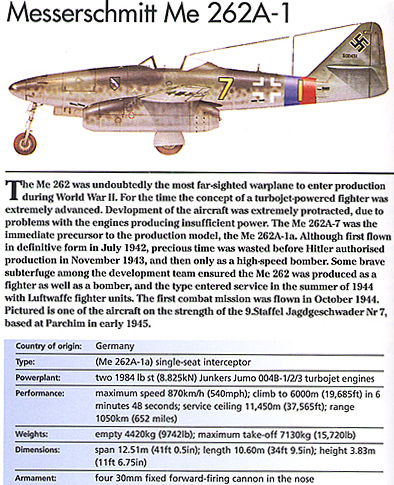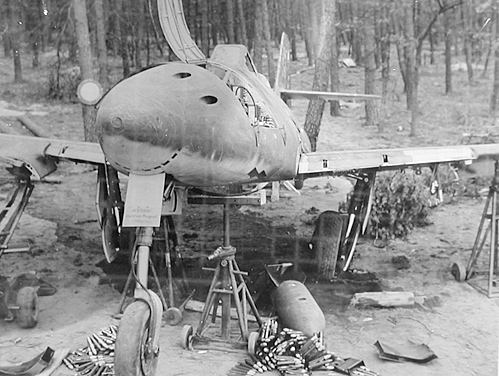 Perhaps the best known of the aviation projects in Nazi Germany which came
to bear fruit was the Messerschmitt Me 262. This was an all-metal fighter
aircraft with gently swept low-set variable-chord wings, powered by the
powerful twin Junkers Jumo 004 B-1 Turbo-Jet engines. This was the first
jet-powered aircraft to enter operational service, on 3rd October 1944.
Perhaps the best known of the aviation projects in Nazi Germany which came
to bear fruit was the Messerschmitt Me 262. This was an all-metal fighter
aircraft with gently swept low-set variable-chord wings, powered by the
powerful twin Junkers Jumo 004 B-1 Turbo-Jet engines. This was the first
jet-powered aircraft to enter operational service, on 3rd October 1944.
Image from Aircraft of WWII. page 230.
The Me 262 project started in 1938, with Hans Mauch and Helmut Schlep working on the powerplant and Hans Antz on the airframe. The task given to Messerschmitt Aircraft company was to develope a fighter aircraft which was to have an endurance of one hour at 530 mph. Woldeman Voight, suggested a design with engines in each wing root. By 7th June, 1939, detailed design drawings had been produced and a wooden model had then been made. On March 3rd, 1940, Messerschmitt was awarded a contract to produce three airframes, designated as the Me 262, for flight testing.
But the Me 262 Project was to suffer a series of setbacks before it actually flew. First, the BMW engine prototype, now known as the 109-003, did not run until August 1940. But it produced only 330 lb of static thrust instead of the 1320 lb which was promised. By August 1941, the BMW engine was still only producing 990 lb of thrust, which was not enough to get the Me 262 into the air. It was not until mid-1943 that 003 produced sufficient power to make the Me 262 fly. But it was found that the BMW engine was to big to be fit into the wing-root mount. So the design of the fighter was modified to carry the engine in under-wing nacelles.
First All-Jet Me 262 Flight
In the summer of 1942, the first pilot-production engines, 004 As, were rolled out. These produced 1850 lb of static thrust and were fitted to the Me 262 V3. In the hands of Fritz Wendel, the first all-jet Me 262 rose into the skies on 18th July 1942. Initially orders were placed for 15 Me 262, which was expanded to 60 by early October, by which time the second prototype had also flown.
On 17th August 1943, a blow fell to the Me 262 program, when the United States Air Force bombed the Messerschmitt factory at Regensburg, destroying important tools needed for the project. As a result, the development program was transferred from Augsburg to Oberammergau. Then came the second blow. This time from Hitler himself.
Luftwaffe General Staff were advocating that bomber production be stopped in Germany and that all efforts should concentrate on fighter types. Goring agreed with this idea, but Hitler did not.
On 7 September 1943, Hitler asked Professor Messerschmitt how things stood with the ME-262, and, to everybody's surprise, asked if it could also be used as a bomber. When he received an affirmative reply, Hitler demanded that the Me 262 be used to carry a 1100 lb bombload to England to continue his harassment raids. And he ordered that Me 262 should be modified for this purpose, even though it was hardly suitable and no adequate bombsight had been developed.
The Me 262 Displayed
According to von Below, Hitler's Luftwaffe adjutant:
- Air raids on 22 and 23 November [1943] caused substantial devastation to the heart of Berlin. The Gauleiter of Berlin, Dr Groeb, reported personally to
Hitler and made particular mention of the outstanding morale shown by the people of the city over the two nights. Hitler was again filled with rage and
anger against the Luftwaffe, which was never able to stop a raid taking place. He repeated these criticisms in bitter terms on 26 November at the
impatiently awaited aircraft exhibition at Insterburg airfield.
All those in some way responsible for aircraft production were present Goring, Milch, Speer, Saur, Messerschmitt, Galland, Vorwald and others. In my opinion the Luftwaffe had repeated the error here of setting out mostly those models which were not yet ready for service. Hitler passed very calmly before the long line of aircraft, which included the newest version of the Me 109, the Me 410, Ar 234, Do 335 and Me 262.
Milch accompanied him with full specifications to hand. Hitler was seeing the Me 262 for the first time and was very impressed by the look of it. He called Messerschmitt over and asked him pointedly if the aircraft could be built as a bomber. The designer agreed, and said that it would be capable of carrying two 250kg bombs. Hitler said, 'That is the fast bomber' and gave orders that the Me 262 should be built exclusively as such. Milch intervened at once to explain that only a number of the aircraft coming off the production line could be released to the bomber role, but Hitler insisted.
Even Goring, when attempting to have Hitler's decision reversed a few days later, was rebuffed sharply. As it turned out, however, the Luftwaffe could only offer the type as a fighter-bomber because a true fast bomber would need extensive redesign for bomb carriage, release gear and sights. Hitler was forced to accept this. On our return to Wolfschanze, I tackled him on the subject in the hope of saving the Me 262 for its fighter role. He replied that in principle I was right and he wanted as many fighters as possible for the Reich, bearing in mind the existing problems--the worst of which would be the Allied landings in France. We had to do everything to prevent this. (from At Hitler's Side, Greenhill Books)
 Fighter Version
Fighter Version
It was not until May 1944 that Hitler agreed to allow production of the 'Schwalbe' ('Swallow') fighter version to continue, but only in parallel with 'Sturmvogel' ('Storm Petrel') bomber at the rate of one fighter to 20 bombers.
Hitler's interference caused delay and design changes on the Me 262 which definitely reduced its efficiency as a fighter. Some 1430 Me 262's were produced altogether in seven main versions, but only more than a third of this number saw action. Over a seven-month period some 100 Me 262's were lost due to accidents during flights and landings.
Unidentified ME-262 overrun by US forces, 1945.
By the spring of 1945, the Me 262 were operating under very difficult conditions, but were still downing significant numbers of American bombers, particularly when equipped with 5.5 cm R4M 'Orkan' ('Hurricane') unguided rocket projectiles.
Even with all the difficulties, the Me 262's still managed to destroy 735 Allied Air Force planes. The highest-scoring Me 262 jet pilot was Oberleutnant Kurt Welter, with over 20 victories. To this day, he is still the highest scoring jet ace. Also 27 other Luftwaffe pilots became jet aces, with five or more victories each, including GeneralLeutnant Adolf Galland, who formed and then commanded the unit 'Jagdverband 7' after being implicated in the January 1945 'revolt' of the Luftwaffe fighter unit leaders.
Conclusion
An analysis of the Me 262 project could be summed up in these words: too little, too late. The two major hold-ups of the project was one: the late delivery of the engines and two: Hitler's constant meddling. Yet still with all these setbacks and all operating difficulties, it is truly remarkable that the few Me 262's managed to destroy 735 Allied Air Force aircrafts. Had the 262's arrived early on time and in big numbers and had Hitler not constantly interfered in the project, the outcome of World War 2 would had been quite different.
Bibliography
Ford, Roger. Germany's Secret Weapons in World War 2: MBI Publishing
Company, 2000, Osceola, WI, USA.
von Below, Nicolaus. At Hitler's Side: Memoirs of Hitler's Luftwaffe Adjutant 1937-1945: Greenhill, 2001.
Back to Table of Contents -- World War Two Newsletter May 2002
Back to World War Two Newsletter List of Issues
Back to MagWeb Magazine List
© Copyright 2002 by Shahram Khan.
This article appears in MagWeb (Magazine Web) on the Internet World Wide Web.
Other military history articles and gaming articles are available at http://www.magweb.com